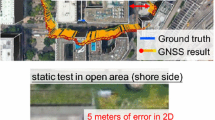Abstract
Since the launch of the first Global Positioning System satellite, the demand for higher accuracy and wider applicability has been continuously increasing. In particular, personal navigation stresses requirements on “seamless” or continuous positioning with higher reliability are needed in urban areas. Unfortunately, urban canyons causing shadowing and multipath represent an adverse condition for Global Navigation Satellite System (GNSS) signal reception, thus leading to poor satellite visibility and low positioning accuracy. In order to overcome such problems, pseudolites can be set up to provide additional ranging signals and aid the carrier phase ambiguity resolution which is crucial for utilizing the full accuracy and wide range capability of GNSS. Pseudolites, which are ground-based instruments that transmit GPS-like signals, can improve the satellite-receiver layout and be used as additional range observations to improve the performance of a GPS-based deformation monitoring system. However, due to economic and environment constraints, the number of pseudolites that can be installed will be limited. More importantly, in order to reduce the areas affected by multi-path of pseudolite signals, locations and antenna pattern of pseudolites have to be carefully examined. This paper shows the development of a simulation system for evaluating the appropriateness and economics of installing pseudolites using precise orbital information of the satellite and a three-dimensional digital map.
Similar content being viewed by others
References
Christian Altmayer, Sven martin, and Stephan Theil. (1998) “Automonous Onboard Orbit and Attitude Control of Geostationary Satellites Using Pseudolites.” Proc. ION GPS 1998, Nashvelle, Tennessee, UT., pp. 1565–1575.
Cobb, H.S. (1997) GPS Pseudolites: Theory, Design, and Applications, A Ph.D. dissertation, Stanford University.
Hofmann-Wellenhof B., H. Lichtenegger, and J. Collins. (2001) GPS-Theory and Practice. Fifth, revised edition, Springer Wien New York.
James Stafford. (1997) “Practical Investigations on DGPS For Aircraft Precision Approaches Augmented by Pseudolite Carrier Phase Tracking.” Proc. ION GPS 1997, Kansas City, Missouri., pp. 1851–1860.
Konish, Y. and Shibasaki, R. (2001) “Development of A Simulation System to Estimate Available Area of GPS and Pseudolite.” Proc. The 22nd Asian Conference on Remote Sensing, Singapore. pp. 1506–1511.
Lawrence, D., B. Pervan, C. Cohen, H.S. Cobb, J.D. Powell, and B. Parkinson (1995) “A real-time architecture for kinematic GPS applied to the Integrity Beacon Landing System.” Proc. ION annual meeting, Colorado Springs, pp. 271–280.
Liwen Dai, Jun Zhang, Chris Rizos, Shaowei Han, and Jinling Wang. (2000) “GPS and Pseudolite integration for Deformation Monitoring Application.” Proc. ION GPS 2000, Salt Lake City, UT., pp. 1–8.
Sandra Verhagen. (2001) “Ambiguity Resolution and Success Rates with an Integrated GNSS-Pseudolite Positioning System.” Proc. ION GPS 2001, Salt Lake City, UT., pp. 3036–3043.
Suh, Y.C. and Shibasaki, R. (2002) “High Accurate and Efficient Positioning in Urban Areas Using GPS and Pseudolites Integration.”Korean Journal of Geomatics, Vol 2, No. 1, pp. 17–24.
Wang, J., Rizos, C., Dai, L., Tsujii, T., Barnes, J., Grejner-Brzezinska, D., and Toth, C.K. (2001) “Integration of GPS and pseudo-satellites: New concepts for precise positioning.” Proc.IAG Scientific Meeting, Budapest, Hungary.
Author information
Authors and Affiliations
Additional information
The manuscript for this paper was submitted for review on February 5, 2003.
Rights and permissions
About this article
Cite this article
Suh, YC., Shibasaki, R. Assessment of pseudolite layout under urban environments using a simulation system for seamless positioning. KSCE J Civ Eng 7, 261–266 (2003). https://doi.org/10.1007/BF02831777
Issue Date:
DOI: https://doi.org/10.1007/BF02831777




